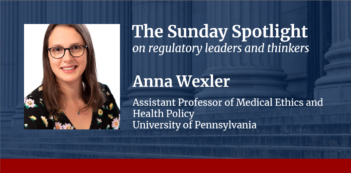
Expert argues that social benefit, not market-competitiveness, should drive health care reform.
Despite winning more popular votes than any presidential candidate in American history, President-Elect Joe Biden’s election came with uncertainty about how he would achieve significant legislation without a majority in the U.S. Senate. This is especially true with health care reform.
Biden campaigned on a relatively moderate promise of creating a federally established insurance plan—a “public option”—that could compete with private insurers. Even if Biden can pass his public option into law, critics argue it would not achieve its primary objective of guaranteeing every American high quality and affordable health care.
In a chapter of a recently edited volume, University of Pennsylvania Law Professor Allison Hoffman highlights what she sees as a central irony of the competitive public option Biden favors: It actually will undermine access and affordability to health care. It will do so, Hoffman argues, by using a regulatory system that primarily values market competition and consumer choice. According to Hoffman, access and affordability can only be achieved if policymakers finally move past the competitive market framework.
During the debates surrounding the adoption of the Patient Protection and Affordable Care Act (ACA) in 2010, policymakers promoted a public option that would indirectly regulate private insurance plans by competing with them. Advocates of a public option theorized that, if the government could provide “a better product for lower prices,” private insurers would also start offering more accessible and affordable plans.
Private insurers, medical providers, and pharmaceutical companies—among others—knew that they lacked several of the government’s key competitive advantages for creating accessibility and affordability. In response, private insurers and their political allies successful opposed the public option, and the Obama Administration eventually dropped it from the ACA.
Hoffman argues that, even if Democrats had managed to include a public option in the ACA, they could only have done so by relinquishing the government’s competitive advantages to appease the public option’s opponents. If this version had ever come to pass, Hoffman insists it would not have meaningfully increased access or affordability because, without the government’s competitive advantages, it would never have offered a “genuinely meaningful alternative” to private insurance. The same will be true today if President-Elect Biden is only able to secure passage of a watered-down public option.
Hoffman also points to a growing body of empirical research showing how difficult it is for Americans to choose the best health insurance plan for their needs and preferences. The power of competition depends on consumer choice, but the research provides reason to be skeptical that consumers will do much choosing over their health insurance.
Despite some reformers’ promise that “market-based approaches to health insurance” will result in “nimble and less bureaucratic” regulation, Hoffman argues they actually result in a “massive regulatory scaffolding to establish choice infrastructure” that only drives up consumer costs.
Instead of relying on the competitive model to expand access and lower insurance costs, Hoffman outlines three alternatives, each of which she argues would provide a more productive way for public and private insurance to coexist.
In the most progressive model, known as “Medicare for all,” the government would make baseline coverage available to all Americans. The government “sets payment rates for goods and services, working to keep spending as low as possible while maintaining a sufficient supply of providers.” In this system, private insurers would play a much-diminished role, as they already do in many other countries. Although this model is probably the best way to guarantee universal access at controlled prices, it is also the most threatening to the public option’s opponents and, therefore, the least politically viable.
The most conservative of the public option alternatives is one that only fills in the gaps by offering coverage to Americans who cannot receive health care through Medicaid, Medicare, their employer, or on the ACA exchanges. Hoffman also suggests a more ambitious version of this model might extend public coverage to everyone on the ACA exchanges.
Finally, Hoffman traces a middle path between Medicare for all and gap-filling, a path that she dubs the “creeping public option.” This model would at first use the public option to fill existing gaps. Over time, though, it would gradually increase the public option’s scope to include more people. One such plan, proposed by U.S. Representatives Rosa DeLauro (D-CT) and Jan Schakowsky (D-IL), would expand Medicare’s reach by automatically enrolling all newborns, eventually leading to universal baseline coverage.
Although this might be a more moderate approach, Hoffman argues that it may not be any more politically feasible than Medicare for all because it would still attract opposition from the private actors it threatens to put out of business. The gradual transition from gap-filling to baseline coverage could also create the same unwieldy market bureaucracy that Hoffman criticizes in the competitive public option.
At this moment, the future of American health care reform remains unclear. Still, as COVID-19 continues to reveal the unique frailties of the American health care system, reform remains an urgent issue. Those looking to fix this system may rely on Hoffman’s critiques to chart their path forward.



